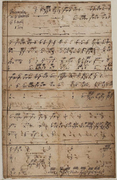Giovanni Gabrieli @ RISM
Martina Falletta
Wednesday, August 15, 2012

August 12 marks the 400th anniversary of the death of Giovanni Gabrieli (ca. 1554 - 1612). His music represents the high point of the Venetian School. Together with Claudio Monteverdi, he helped with the transition of Italian music from the Renaissance to the Baroque. Early on, he made use of basso continuo in his compositions and began a new era with his canzonas.
Gabrieli’s career began in Germany, when he was a member of the Hofkapelle in Munich under Orlando di Lasso from 1576-1579. During his 33-year tenure in Venice, and prompted by the large organs that were across from each other at the San Marco basilica, he perfected polychoral music, sometimes employing large instrumental forces.
Giovanni Gabrieli’s oeuvre essentially consists of three genres. The motets (concerti), madrigals, and instrumental music mirror his lifelong associations with San Marco in Venice, the Scuola di San Rocco, and other churches.
Gabrieli also had an exceptionally good reputation as a teacher. Representatives from all over northern and central Europe sent their musicians, including Hans Leo Hassler and Heinrich Schütz, to Venice to study with Gabrieli.
Around 80 printed sources of Gabrieli’s music are known to have been printed during his lifetime or shortly after his death. Richard Charteris provides a substantial list in Giovanni Gabrieli (ca. 1555-1612): A Thematic Catalogue (Stuyvesant: Pendragon Press, 1996). Among the best-known publications are the Concerti di Andrea et di Giovanni Gabrieli (RISM A/I: G 58 und B/I: 1587|16), the Sacrae symphoniae (RISM A/I: G 86) and the Symphoniae sacrae […] liber secundus (RISM A/I: G 87). A number of these pieces have become available worldwide as digital copies. Online portals where you can see them include Early Music Online, Museo internazionale e biblioteca della musica di Bologna and Gallica.
The RISM online catalog contains ca. 270 records from 38 different libraries for Giovanni Gabrieli’s compositions. The numerous Gabrieli manuscript copies, which were presumably brought to Kassel by Heinrich Schütz and account for a special kind of cultural import, are unfortunately still missing from the RISM database. In addition, not a single Italian manuscript source by Gabrieli is indexed in RISM.
Share Tweet EmailCategory: Musical anniversaries

